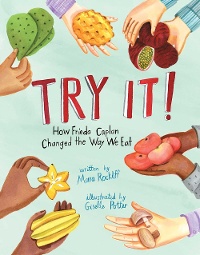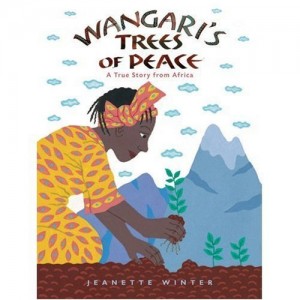Try Food as a Way Into Reading

Learning is best done through experience, and food is definitely a way into learning for many of us. To tie reading in with some cool hands-on (and mouths-on) experiences, grab this biography, Try It! How Frieda Caplan Changed the Way We Eat written by Mara Rockliff and illustrated by Giselle Potter.
Apples, bananas, tomatoes, potatoes, these were almost the only things that Frieda Caplan saw when she went to her produce market. But Frieda wanted to try something different.
She brought mushrooms to sell. Everyone thought they were weird.
Until they tried them. Suddenly everyone wanted mushrooms. People even dubbed her the “Mushroom Queen”.
But she wanted more than just mushrooms.
She tried kiwi, jicama, sugar snap peas, cherimoya, champagne grapes. Red bananas, baby corn, star fruit! All kinds of new foods! She brought them all to her produce market.
And people tried them. And liked them!
A master teacher, Ed Spicer, taught his first graders that learning is all about trying. He encouraged his students to celebrate trying something new, even if they weren’t successful at first, even if they didn’t like it – that in itself is learning. You can create really memorable learning experiences by reading Try It! How Frieda Caplan Changed the Way We Eat and talking about new food.
Read this book with your kids/students/campers and talk about foods that seemed weird before you tried them. Are there foods they didn’t like before but now they do? You can make charts together of interesting foods and kids can put their names in the columns of “Yes, I like it” or “No, I don’t like it” or “I don’t know – I haven’t tried it yet”. If you have food magazines, kids can cut out foods they like and foods they want to try. Model for them, if kids start saying something is gross, that you used to think a certain food was gross but that part of growing up is that your tastes develop. Tell them about foods you used to think were weird that you now enjoy.
If you’re working with your own children or with children you know don’t have any fruit/vegetable allergies, you can bring in something like star fruit to try. I have researched allergies and it turns out for almost every food, someone is allergic to it. (Check out verywellhealthy.com – I never knew some kids aren’t bluffing about being allergic to broccoli!) To play it safe with a large group of kids, pick a cooked fruit, like applesauce. (Still, avoid anything with strawberries.) Do you think green applesauce is weird? What about pear sauce? Weird food is only weird until you try it!
Read MoreEleanor, Quiet No More
 This morning, I sat basking in the presence of an amazingly talented author. Doreen Rappaport was speaking at our local university, and because my husband, Matt Faulkner, will illustrate her biography of Elizabeth Cady Stanton, Matt and I were able to sit in on her lecture. I’ve been a huge fan of Doreen’s work for years, but hearing her speak made me want to read everything she’s ever written. It reminded me just how powerful it is to hear an author or illustrator in person.
This morning, I sat basking in the presence of an amazingly talented author. Doreen Rappaport was speaking at our local university, and because my husband, Matt Faulkner, will illustrate her biography of Elizabeth Cady Stanton, Matt and I were able to sit in on her lecture. I’ve been a huge fan of Doreen’s work for years, but hearing her speak made me want to read everything she’s ever written. It reminded me just how powerful it is to hear an author or illustrator in person.
Doreen has a series of picture book biographies about famous Americans that perfectly hit that Common Core Standard of Range of Reading for elementary students. I love using her books because her writing style is so engaging that any one of them make for a great Craft & Structure lesson. Take, for example, Eleanor, Quiet No More written by Doreen Rappaport and illustrated by Gary Kelley. Gorgeous, large illustrations accompany the story of Eleanor’s life. Yes, you will find a timeline of her life and key facts to use for writing reports, but more importantly you will get a sense of who this remarkable woman was. Direct quotes are written in huge letters, and discussing why this is can be the beginning of the lesson on author’s craft.
Doreen has video clips of Eleanor Roosevelt and Common Core-aligned study guides with cross-curricular activities on her website, but I think one of the best ways to extend this book is to have your students contact Doreen herself. If you aren’t able to bring her to your school, email her questions, or snail-mail her letters. Allowing your students to personally connect with authors and illustrators will inspire them to appreciate books on an entirely new level. Many authors and illustrators will Skype with students across the country, but check out who lives in your state. Michigan has a list of authors and illustrators available for school visits through the Library of Michigan website. The Society of Children’s Book Writers and Illustrators (SCBWI.org) has a speaker’s list that is searchable by region. All of your students will benefit from hearing an author or an illustrator speak, but for those who dream of making their own books, it may be the spark that lights the next Gary Kelley or Doreen Rappaport.
For more information about the author, please visit doreenrappaport.com.
For more information about the illustrator, please visit garykelleyonline.com.
Read MoreCelebrate America with “Seed by Seed”
 What better way to celebrate the Fourth of July than with a slice of apple pie and a beautiful picture book about an American legend? Seed by Seed: the Legend and Legacy of John “Appleseed” Chapman written by Esme Raji Codell and illustrated by Lynne Rae Perkins is one of the most thought-full biographies I’ve read. Codell and Perkins invite children to leave behind the world of concrete, cars, and screens, and enter a time when one man made a huge impact on our country, seed by seed.
What better way to celebrate the Fourth of July than with a slice of apple pie and a beautiful picture book about an American legend? Seed by Seed: the Legend and Legacy of John “Appleseed” Chapman written by Esme Raji Codell and illustrated by Lynne Rae Perkins is one of the most thought-full biographies I’ve read. Codell and Perkins invite children to leave behind the world of concrete, cars, and screens, and enter a time when one man made a huge impact on our country, seed by seed.
John Chapman, or Johnny Appleseed, planted so many seeds across America that chances are the apples you eat are descendents of his trees. His legend of humble generosity is a story every child should know. I love the five examples Johnny Appleseed planted that we can follow:
“Use what you have.
Share what you have.
Respect nature.
Try to make peace where there is war.
You can reach your destination by taking small steps.”
And I just want to hug the book every time I read the end:
“Seed by seed, deed by deed,
Johnny Appleseed changed the landscape of a nation.
And now it’s your turn.
One small deed, every day.
What seed will you plant?”
Pick this book to use in your classroom as a biography, as part of a unit on apples, in an American legends unit. Codell, who knows what works in the classroom (remember the terrific book about a teacher’s first year called Educating Esme? That’s her!) has great ideas in the back of the book, including a recipe for apple pie. There’s also a fantastic free teacher’s guide on harpercollins.com. I’d have students help me make a yummy apple treat to share as we discuss the five examples of Johnny Appleseed. Connecting what Johnny did in his life to each of those ideas will be a good Common Core Key Ideas & Details lesson (plus you can put a checkmark next to Range of Reading). You can talk with your students about putting these examples into place in your classroom. Seed by Seed could inspire your students to plant seeds of kindness, and those seeds could spread through your school, your community, your nation. That is as wonderful and American as apple pie.
Have a happy Fourth of July!
For more information about the author, please visit planetesme.com.
For more information about the illustrator, please visit lynnerae.com.
My favorite Earth Day book: Wangari’s Trees of Peace
 Sometimes I fear that I can’t make a real difference in helping the planet, but Wangari’s Trees of Peace: a true story from Africa by Jeanette Winter shows how powerful one person’s actions can be. Wangari Maathai was devastated to see how barren Kenya was after thousands of trees were cleared. Soil was eroding and crops wouldn’t grow. The birds were gone. Women walked for miles to gather firewood. “I can begin to replace some of the lost trees here in my own backyard – one tree at a time.”
Sometimes I fear that I can’t make a real difference in helping the planet, but Wangari’s Trees of Peace: a true story from Africa by Jeanette Winter shows how powerful one person’s actions can be. Wangari Maathai was devastated to see how barren Kenya was after thousands of trees were cleared. Soil was eroding and crops wouldn’t grow. The birds were gone. Women walked for miles to gather firewood. “I can begin to replace some of the lost trees here in my own backyard – one tree at a time.”
Wangari started with nine seedlings, which grew into a nursery. Wangari gave new seedlings to village women for them to plant, and gave them money to keep those trees thriving. When Wangari tried to stop the clearing of old trees, she was beaten and arrested. But her message of caring for the Earth was taking root just like her trees were, and because of her, Kenyan women planted over 30 million trees, saving their land and making life there better.
For Earth Day/Arbor Day/natural resources units/biography units/non-fiction read-alouds that you can finish in one sitting, this is my new go-to book. Just by reading it and discussing it with students, you’re hitting the Common Core Standard of Range of Reading (a biography that teaches science and social studies? Non-fiction score!) Wangari’s Trees of Peace is also excellent for an ecological cause-and-effect lesson, one of the big pieces of Key Ideas and Details. Using the book for reference, students can write and draw the effects of deforestation (crops wouldn’t grow, birds were gone, lack of firewood) and the effects of planting all those trees (women don’t have to walk so far to gather firewood, more birds, crops growing in the soil.) Winter’s picture book doesn’t delve deeply into the science of why a lack of trees leads to soil erosion, so you can share Planting the Trees of Kenya: the story of Wangari Maathai by Claire A. Nivola if you need to build that knowledge with your students. Use both books as resources for student writing and drawing, and now you’re Integrating Knowledge and Ideas!
If in the past you’ve received more apple-themed coffee mugs than you need as end-of-the-year teacher gifts, you can suggest that in lieu of a present for you, students can give a gift to us all by planting a tree. If you can spring for a seedling or if your parent-teacher organization will chip in, plant a tree with your students and let them help take responsibility for watering it (seeds are cool, but watering a visible seedling is way more exciting than watering a patch of dirt.) Wangari’s Trees of Peace may plant in your students a dedication to care for our planet.
Read More







